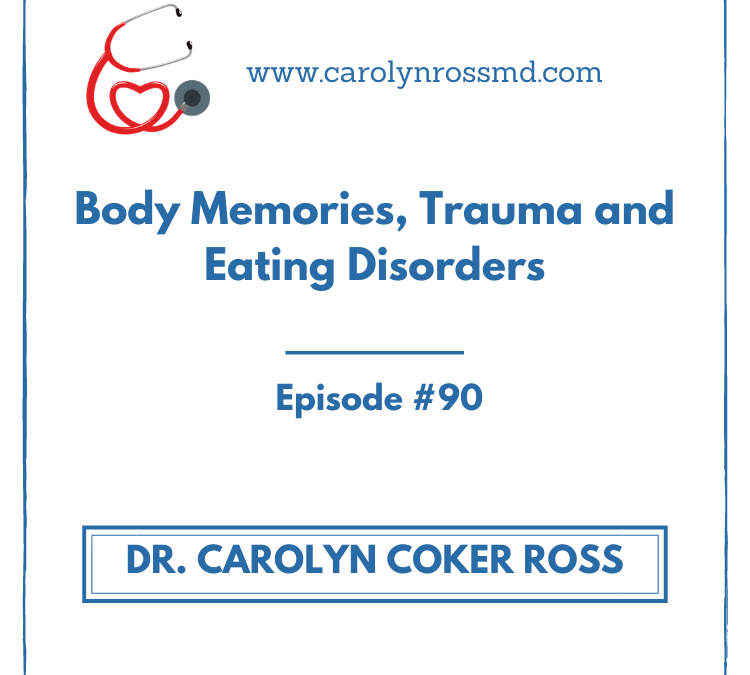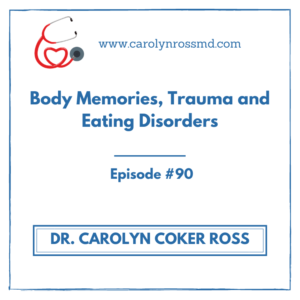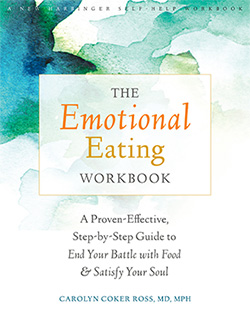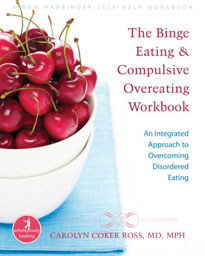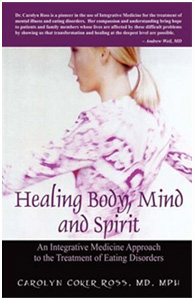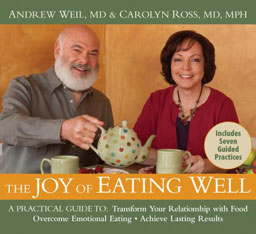Traumatic life experiences, including childhood trauma and the relationships you have with your caregivers growing up has a direct affect on the nervous system – often throwing it out of balance. An out of balance nervous system can make it difficult for you to tolerate your emotions and this then lead to using food (and other substances and behaviors) to numb or manage your anxiety, sadness, fear, anger and other emotions. In this episode, I talk with Irene Lyon from Vancouver, Canada about the links between trauma, body memories and binge eating, compulsive overeating, food addiction and emotional eating.
In this episode you will learn:
1. The effect of trauma on the nervous system.
2. How to use your body sensations and body functions to help you understand your emotions.
3. How to release trauma using your body’s wisdom.
Guest: Irene Lyon
Guest Bio: Irene Lyon, MSC. and nervous system expert, teaches people around the world how to work with the nervous system to transform trauma, heal body and mind, and live full, creative lives. To date, her online programs have reached thousands of people in over 60 countries. Irene has a Master’s Degree in Biomedical and Health Science and also has a knack for making complex info easy for ALL of us to understand and apply to our lives. She has extensively studied and practices the works of Dr. Moshé Feldenkrais, Peter Levine (founder of Somatic Experiencing) and Kathy Kain (founder of Somatic Practice). Irene spends her free time eating delicious food, hiking in the mountains or walking along the Pacific Ocean in her hometown of Vancouver, British Columbia.
Guest website: https://irenelyon.com/
If you’re interested in learning more about food addiction, enter the book sweepstakes to win a copy of The Food Addiction Recovery Workbook.
Schedule a free consult to discuss your food and body image issues: https://findingyouranchor.as.me/CONSULT
To learn more about The Anchor Program a 12-week non-diet program offering ONLINE group and individual sessions for the treatment of binge eating, emotional eating, food addiction and compulsive overeating. Want to learn more about the Anchor Program? https://AnchorProgram.com
Hi everyone. This is Dr. Carolyn here and welcome to episode number 90. We’re getting awfully close to number a hundred. I think we’re going to have to have some special gifts available to hand out when we get to number 100. But anyway, we’re not there yet. This is episode 90. We’re going to be talking about body memories, trauma and eating disorders. And I have a special guest by the name of Irene Lyon. Irene is a nervous system exper,t teaches people around the world, how to work with the nervous system to transform trauma, heal body and mind and live full creative lives. To date her online programs have reached thousands of people in over 60 countries. Irene has a masters degree in biomedical and health science, and also has a knack for making complex information easy for all of us to understand and apply in our lives. She has extensively studied and practices the work of Dr. Moshé Feldenkrais, Peter Levine who’s the founder of somatic experiencing and Kathy Kain, founder of somatic practice. Irene spends her free time eating delicious food, hiking in the mountains or walking along the Pacific Ocean in her hometown of Vancouver, British Columbia. So I will be a welcoming Irene to the show. I think you’re going to enjoy this show. She really connects in a way that most people don’t the impact of trauma on the body and on the nervous system and what you can do about it. She’s actually going to give you an assignment or a homework Lifework you can do at the end to start practicing this. So stay tuned.
Welcome to the Dr. Carolyn Coker Ross Show. I’m Dr. Carolyn and I’m a medical doctor who specializes in treating eating disorders and addictions. I’ve been working with individuals with binge eating disorder, compulsive overeating, food addiction, and emotional eating for over 20 years. I’m also the founder of The Anchor Program an international online non diet coaching program for people with food and body image issues that you can access from the comfort of your own home. Please check out my books, The Emotional Eating Workbook, The Binge Eating and Compulsive Overeating Workbook and my latest book, The Food Addiction Recovery Workbook, I’m on a mission to help individuals just like you transform your relationship with food and with your body.
Dr. Carolyn: So let’s get started talking with my special guest Irene Lyon. And I want to know about this polyvagal theory. I’ve heard about it. I have some friends who endorse that if somebody approaches you, or if you have an altercation in the grocery store over tuna, the first thing that happens is your body goes into fight or flight where your heart races, your breathing gets rapid. And all of those things that will enable you to fight or flee. And so from the polyvagal theory, what happens next and what does it have to do with trauma?
Irene: We would hope that if the pieces got interested Carolyn is it depends on the two people and their level of nervous system regulation. So if my sense is, if we were in a grocery store and one of us took the last can of tuna, we would be civil about it. We’d talk, we’d laugh. Oh, I’ll get salmon today with two regulated nervous systems. But if the let’s just say the other individual isn’t, if they aren’t are living in fight flight and chronic stress, they might not be so interested in having a nice conversation that’s regulated. So it really depends or if I grabbing that tuna I’m in fight or flight, that also will reflect to that person. So it really depends also on the two people that are existing together.
Dr. Carolyn: Why do we need to know this though? What, why is this important to understand?
Irene: What I have found in my, working with my students is that by understanding this theory, this education, and of course doing a little bit of work to learn how to track our internal mechanisms, that kick us off and to say fight flight, or even freeze the shutdown response, which is super important. We can begin to put pauses and spaces in our interactions to allow a different path to be taken that might be more socially engaging, a bit more emotionally mature.
Dr. Carolyn: That makes sense. So, in my experience though, people who’ve had either childhood trauma or, you know, other forms of trauma tend to be more in that fight or flight, you know, situation on a regular basis. They’re more reactive, maybe more often on red alert is what I call it. So they’re in the grocery store and getting the last thing of tuna and you come up and confront them, then automatically their kind of trauma reactivity is going to come into play. So are you working with clients like that and teaching them how to be less reactive?
Irene: A hundred percent.
Dr. Carolyn: Okay. And how do you do that?
Irene: Yeah, it’s a long process and that it isn’t something that can occur quickly. However, we are blending. I am blending theory and education along with practical exercises that blend my work within the Feldenkrais method world and somatic experiencing, and also something called somatic practice. And so it’s really teaching individuals how to track their internal environment and listen for the cues that might let them know, oh, I’m going into that attack mode or I’m sensing myself wanting to run away. Or what I have found is actually more prevalent, at least in Western civilization is I’m going to shut down and just numb it all out.
Dr. Carolyn: It goes to people.
Irene: Yeah.
Dr. Carolyn: It goes to people that’s really common nowadays, you can have a disagreement and then you never hear from that person, you text them, you call them and they just go straight because they’ve shut down. So when we’re talking about doing this, I think it’s important for people to understand that something I’ve talked about in these podcasts before, which is that trauma can live in the body and you talk about how memories get stuck in the body because that’s, what’s often getting triggered or those memories. So can you say a little bit about how memories get stuck?
Irene: I sure can. So when we think of trauma, the one thing to understand is there are many different types of trauma. And yet one very clean, simple definition is anything that the human system cannot integrate and processed in the moment it’s too overwhelming. And so we shut it down and we trap it inside. If we are pre-verbal for example, so a child, a human
Dr. Carolyn: Like under the of two maybe or one
Irene: Two, Three, depending, lots of things might happen to us that are scary before we can speak and make understanding and memories. So there’s that kind of early stress and trauma where things that occur to us get really stored in the body because we’re not making a conscious acknowledgement of them. And so one of the things that a lot of humans experience would be say, panic, that comes out of nowhere or behaviors that don’t make sense. And those can often be traced back to these storage fight flight patterns. Let’s say you were a premature infant and you had to be in an incubator with tubes and stuff within your body.
Dr. Carolyn: Sticking needles in you to draw blood.
Irene: It hurts, you know. But at that little age, you’re not making sense of it. But if I give you an example of, let’s say post pre-verbal, so say you’re six years old. And this came up as a student in one of our, uh, classes a little while ago is they were working with a part of their body through, we would use touch. We use intention tracking, sensation, movement. And they were very slowly deliberately with the part of their body, an area called the diaphragms, which is an osteopathic tradition of these layers of the viscera. And they had a memory of being in another country. And this country is where they grew up in as an infant and they didn’t give me or give us the history, but they knew that that time in their life, it was highly stressful. It was highly traumatic. And just by tuning in and touching and connecting. And of course we were already eight weeks into the program. So there had been foundational layers built this, this memory, we would call it declarative. I’m in this park, I’m in this home, mom’s screaming, dad’s upset. However, it might be, it did come through another student. And this is a very common thing. We were working with some areas of the pelvis, which hold a lot of emotions, you know, trauma, the big muscles, the genitals, even the lower gut. And they were working again with this way in which I get people to gently enter into these areas. And they had a memory of falling down the stairs at grandma and grandpa’s house and feeling the bump and bump. And it hurts, but they recall never crying.
Dr. Carolyn: Yeah.
Irene: And so depending on how our caregivers connect with us and allow us to feel that pain, we might shut that big shot into our system and it can actually shut down an entire body part. And we know this with injuries, people get a broken arm and it, it doesn’t feel quite the same afterwards. Um, and so part of my work, Carolyn is to help folks learn the theory. So they understand why do I want to touch these parts of my body and wake them up. But then when those things do wake up, they have the higher brain awareness to go. I’m feeling something Twitch or something, get hot in this area. And rather than just dismissing it as something not important, they then contract it, be with it, sense it and release, integrate.
Dr. Carolyn: I think people listening might have a hard time understanding how this all works, but I like your example of the kid bumping down the stairs, because I think, you know, that’s something that could have happened to most anyone, but the significant part of that is somehow he had gotten the message that within his family, we don’t cry if we’re hurt. And so, you know, him falling down the stairs and feeling it being very, very uncomfortable for him, but instead of the natural response of breaking into tears and then mom or dad comes and picks him up and soothes him, uh, he didn’t, he shut down or she shut down and went into kind of that numb response. And I think a lot of people listening can identify with that because they know that in their own families, they had that message of big girls don’t cry or boys don’t cry
Irene: Or getting angry
Dr. Carolyn: or getting angry, oh, for sure for women, girls never get angry. If you’re angry, you’re called a bad word. Right.
Irene: Oh yeah. I mean, anger is one of the most misunderstood emotions from what I’ve learned and one of the harder ones to help someone feel comfortable with. Um, and it’s been tracked and traced a lot to cancers, repression, depression in the work I’ve done with Peter Levine. One of the, one of the masterclasses he teaches is titled, Depression, Aggression, and Life Energy.
Dr. Carolyn: That’s a good title. I love it.
Irene: It is. And so, you know, if you’re that child that feels like they’ve been wronged or hurt and sometimes kids are hurt by their parents and they try to fight back and then what happens? They get shut down, shut down or more abuse. And then they realize it’s not okay to express my life force energy. So I’m just going to be very quiet
Dr. Carolyn: Or make myself invisible. But I think it also happens to adults. I think about it, that situation in my own life, where I was in, you know, involved in something that I loved doing and not to get too in detail. But, as part of what happened, you know, this, I was involved in a group. It went on for like six or seven years, loved it and met so many great people and blah, blah, blah. And then at some point something happened, um, and there were some betrayal and I was hurt. And without realizing it, I went back into kind of a childhood pattern of, okay, well, you know, that happened, just keep moving, keep working, keep doing your thing. But not even realizing that I had shut down to maybe other opportunities to meet new people or to be involved in other things that could be just as good. And I think that happens a lot with, you know, many of us.
Irene: Oh yeah. It happens so much a topic that has come up a lot this last year is self-sabotage and people getting into bad situations over and over again and not wanting to, and this actually goes beautifully with the polyvagal element that we started with Stephen Porges also coined a term called neuroception. I don’t know if you’ve come across that term.
Dr. Carolyn: No
Irene: Which is the perception, the neurological perception of either safety or danger. And so we were brought up in, let’s just say household where it wasn’t okay to be our rambunctious, creative, juicy, childlike self, we shut down. Or if we were in an environment that was downright abusive and scary, that is all we know. We actually don’t know. And you hear this from people say, I knew something wasn’t right. When I went to a friend’s house and there wasn’t screaming at the dinner table, right. It wasn’t this fight to eat food and you realize, okay, something’s not right here. But if we don’t come to that, understanding that okay, that abuse or that adversity, or that shutting down, that isn’t how it should be. We will find relationships in our adult years and our teenage years that that are, and I say this with air quotes safe to us, but it’s just because that’s what we’re used to.
Dr. Carolyn: Yeah. They’re comfortable. It’s more comfortable. Because that’s what we know.
Irene: Yeah. Exactly.
Dr. Carolyn: That’s, I think that’s a really important concept for people to understand, because it explains so much of why, you know, I have so many of my patients who struggle with eating disorders who say like, well, why can’t I stop using food for comfort? And I think that ties into what you’re talking about, which is if you’ve developed a pattern from childhood that when things get tough or when your life is chaotic in your family, you turn to food, then it’s really hard to let go of that feeling of comfort. And then in relationships, like you say, we gravitate. And then we say, why did I marry that person? You know, they’re just like my, you know, abusive dad or their mother or mother, or they have a substance problem. Like my mother did. And so on. But like you said, it’s, it’s almost like our nervous system while you, you said it is like our nervous system doesn’t know any different. And so on an energetic kind of perspective, we are drawn to that because it’s something we know,
Irene: A hundred percent we’re wired in a certain group, a certain pattern. I always liken that to, if you ever drive down the big interstate freeways, and there’s the one lane where big trucks have molded like divots, and if you’re driving your little Corolla Toyota or whatever, you can get pulled into those really quickly. And what I find with my students who have grown up in turmoil and chaos is until they understand, because he said that, why is this theory important? When they understand that science see nervous system, this is how you were wired. This is what safety was to you. They go, oh, that’s why it actually feels better when I’m with someone who makes me feel terrible about myself.
Dr. Carolyn: Yeah. Yeah. If you grew up in a home where you were, I have a patient like that too. I grew up in a home where she was constantly being told that she was nothing, that she was, you know, nobody, that she was never going to amount to anything and, you know, here she is an older woman now and just now realizing that she has been repeating that same message over and over by her own choices, which aren’t really choices. If they’re built into your nervous system, you’re not consciously choosing you’re unconsciously falling into that groove that you’re talking about on the freeway
Irene: A hundred percent. And when one can really make the decision, I want to change lanes and be in a different path. Then the real work and the real interesting stuff begins. Because one thing I’ll hear is let’s say someone like your client, your patients finds a healthy relationship. What will occur more often than not, as they know cognitively, this is healthy. I’m being treated well. I’m being listened to, I can cry when I want, I can express my anger and they’re not going to tell me to leave. A lot of people will feel like true visceral disgust for that. And it’s a real thing, and it’s not that you’re broken or that this is disgusting, but it’s the polar opposite to what you got. And if we think of things like food and other behaviors that help see this, it’s a, it can be a way to calm us, to settle us. And it’s familiar. Right?
Dr. Carolyn: Yeah. Well, we, you mentioned anger a little bit ago, but I know you also say that anger can be medicine. Why do you say that?
Irene: Well, anger from a real pure primal emotional state, I, and I wanted to stay anguish, anger from violence or hate, right, right. Where you’re harming. But I often use the example. Let’s just say someone was attacked when they were young and they, and it could have, it could be physical. Sexual could even be being held down on a first surgical intervention, which is actually more common than we realize. And the person wants to fight. They want to leave. They want to get out of that situation, but they’re held down because the person or the people are stronger, we will store that anger, that aggression, that fight flight in our bodies and our nervous systems. And so one of the things that is super important is to realize that a, that fight energy was actually valid and warranted, but for whatever reason, you couldn’t get it out. And one of the hallmarks of having healthy anger is it gives us energy. It gives us the, the root of the word aggression comes from Latin, which is gravity, which means to push forward. And if you think of folks who have trouble with resistance, with procrastination, with collapse in their bodies, which is very into decorative of early trauma, still being stuck in the system, we actually want that person to feel positive life force energy, and maybe it is imagining growling at their abuser. I’ve even done work where we are actually imagining. And this is this isn’t in real life, but imagining what would you do if you could have harmed that person that was harming you?
Dr. Carolyn: Yeah. It really imagining a situation where you are empowered to react with you. Weren’t able to do in the original situation.
Irene: A hundred percent and how that looks is so individual. And this is where we get into some trouble with some cathartic practices that just say, take this baseball bat and hit a pillow, you know, which is classic of older workshops, um, that were more of Peter Levine’s day in the sixties and seventies when I wasn’t doing this work. But what we find is that, that while my feel good and get a sympathetic reaction, endorphins, get going, if it’s not connected to the event and what that person, maybe that person wanted to tell the person to screw off, maybe they wanted to push them on her ledge. Maybe they wanted to do something else. If it doesn’t match what their organic physical body wanted to do, it will be very tough to heal at that root level, that desired fight response. And so when we can get that stuff out, it is very healing, tension shifts. People’s gut brain come back online because they’ve been holding that emotion and holding anger back. It’s like a dam. I always think of a river with the dam. There’s a reason why water held back creates electricity. There’s a lot of power in that, right? So if we think about anger being held back in the jaw, in the gut, in the throat, we’re holding back a lot of energy and a lot of symptoms can actually be created when we’re holding back that anger.
Dr. Carolyn: Yeah. So I, I think, you know, what I’m getting as a whole picture from what you’re saying is something happens to a person and then that whatever happens to them, whether it’s one thing or a series of things or different things that happen in different times can be stored in the body and also can cause sort of, uh, uh, behavior pattern, whether it’s fight or flight or freeze. Right. And then what, what happens from that is, um, they then gravitate as adults to patterns in, in their family that were familiar and comfortable to them, whether it be chaos or being with someone with substance use or being with the ranger or whatever it is, being with someone who cheats on them all the time, whatever they have been exposed to that was their original kind of patterning that caused them to, you know, to have the trauma response. And so it seems like what you’re saying is given that all of this really does also live in the body. I mean, yeah, people have memories and all of that, but, you know, just recognizing or remembering what happened, rarely if ever, uh, releases or heals the trauma. And so what you’re really talking to us about is how we can use the body through the somatic practices, body practices, to help release the trauma in our bodies. While at the same time, we are connecting to the knowledge about what the trauma did and how the pattern caused us to be this way, all of that. So it’s a kind of a combination, like you said, of educating people about the, you know, the neurobiology, but also of really releasing the trauma that’s in the body.
Irene: You got it. Yeah. You said it perfectly. And one of the things that I like to say is we’re trying to reverse engineer in a sense, um, because what I do work with students at center group, large groups, and we’re, I’m never in that setting, asking someone, what are all the things that occurred to you? What are the things that you want to work with? We’re actually starting with the education we’re starting with, how do you orient to your environment? Do you even know you have an environment around you, which is one of the first things we teach, right? Um, because when we are under intense stress, we actually disconnect not only from the physical, but also from the environment. And so we’re blending the mind, the body and the environment, and what occurs when someone really trusts that process, which is different than how we’ve traditionally done it. And they trust it and they just kind of work with it. It’s like learning a second language as an adult. They’re learning their ABCs, their 1, 2, 3 session structure. And then all of a sudden they’re like, oh my God, I can speak a full sentence and converse with myself. And there’s a funny thing that happens, Carolyn. It’s almost as if the deep, deep somatic memories are like, oh my goodness. Oh my goodness. They’re finally connecting to the environment. They are sensing the gut and the immune system and all these things. And now we can let this out because they have the capacity to handle as an adult, the big, bad, scary stuff that occurred when I was four. And I didn’t know how to cause no one was there to help.
Dr. Carolyn: Yeah. It gives a container so that people can feel safe when they are going through this kind of work. And I think that’s the biggest misconception that the patients I work with with trauma have that they’re going to somehow, have to go back and relive all the trauma. But like you said, the important thing is you’re no longer a child being traumatized. You’re an adult. Now just looking back on your childhood trauma and as an adult, we have more skills and can learn even more skills in which to deal with and to heal our trauma. What’s been a pleasure having you on the show. Is there any exercise that you can leave for the clients to practice for our listeners to practice.
Irene: Yeah, you know, one of the more potent ones and it’s going to sound a bit weird, but everyone, you know, they come in and like, oh yeah, yeah. I want to release this trauma and do all this. And I say, okay, great. And first, can you listen to your internal biology? And one of the more powerful ones is listening to when we have to use the toilet, but like, but you know, the bladder, the, the, the bowel’s gas. So the reason I say that is the autonomic nervous system, which governs the fight flight freeze. It also governs the digestion, the bowels, all the things, everything. So when we actually can be better listeners of those things that we are feeling because we’re eating and drinking liquid and getting hot and, you know, getting cool and all these things, it actually creates a better relationship with our internal biology. I have spoken to so many people who will say, oh yeah, I’ll sit and not go pee for like two hours. Yeah. And I know I have to, but I ignore it. And I say, well, what would it be like to actually feel that impulse and granted there’s facilities at your disposal, do that and feel how you take care of your system at that level. And it even goes with food when you’re hungry eat.
Dr. Carolyn: Yeah. It’s really just about getting in touch with your body and being able to feel what your body is feeling. And I think that that’s a problem for most people in the Western world, but it’s particularly a problem. I know for my patients that I work with with eating disorders, they kind of have a life in their head. And which one of my groups recently named that world that we live in, in our head is planet utopia. That’s where, you know, I am going to spit into a size two, no matter what the evidence to the contrary. And I am going to find the perfect mate and you know, I’m going to be perfect at doing this and my diet’s going to be perfect, but they don’t live in their bodies, which is what is called what I call the real world. So, so what you’re suggesting with the body function awareness is connecting to the real world.
Irene: The core world. And one more thing I will add if I may, is it, it, it also goes back to those first few years, but even those first few weeks and months of our lives, when we are completely dependent on our primary caregiver, usually our mother, how she, how they listened to our needs when we’re hungry, when we’re cold, when we have gas, how we’re touched when we’re changed, how we’re held, all of that will determine how well we connect to our body later on. So if we were handled with a lot of roughness or we were left to cry ourselves to sleep when we were hungry, or we were scared, that’s the start of our system losing those signals.
Dr. Carolyn: Yeah. That’s very good. Yeah. I think that’s important.
Irene: So that would be my one. I mean, that’s not everything, but that’s one of the key ones that we can do.
Dr. Carolyn: And it’s simple. It’s easy to do. You don’t have to have a PhD in neurobiology to do it.
Irene: Yo gonna to bathroom go and also, you know, when you’re passing gas, we have in our society, this way of feeling shown, we’d have to say, excuse me, pardon me for basic biological impulses that are just needing to release what has to be released if we think of the animal kingdom they’re not asking permission for when they do those.
Dr. Carolyn: Oh, yes. I used to have a dog who was very good at passing gas. Smelly gas. I wanted him to apologize. Okay. Well, I want everyone to know that we’ll put in the show notes, how you can contact Irene and find out more about her work. And I, again, I thank you for being on the show. It’s been a pleasure talking with you.
Irene: You’re welcome. It was great to meet you and have a chat.
Well, I hoped you enjoyed my conversation with Irene Lyon. I’m putting in the show notes, how you can connect with her on a website. And I was really impressed with her work and the amount of qualifications that she has, of course, and also how she connects the body to body memories and how trauma stores memories in the body and has an effect on the nervous system. So I think it’s really important for those of you who have experienced trauma to not just think of it as something that is in your mind or something you are thinking about, but to recognize that it has a full body impact. And that’s what then leads to the effect of the nervous system on your emotions and your ability to manage your emotions, and then the need to use food as another way to numb those emotions and regulate the nervous system. So I hope you’ve enjoyed that next week. We’re going to be talking about what I call, stop the sabotage and other words, we’ll be talking about how we sabotage ourselves, why we do it and how we can stop it. Please give us a five star rating and share the podcast with anybody that you know, who may be interested and join us next time for episode number 91 Stop the Sabotage. Thanks for listening. This is Dr. Carolyn signing off

